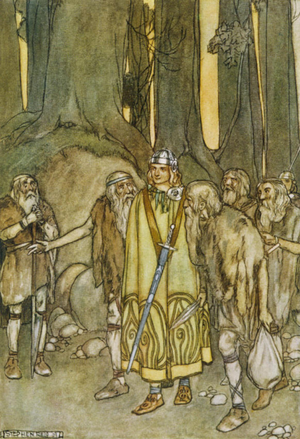Narvic Cults
Prior to Iberic colonisation in the 17th century A.D, the various Narvic Clans and Kingdoms were host to numerous cults. All were pantheistic, following the common Narvic Pantheon or Deiswein. Many of them were devoted towards a particular social role or occupation. In popular culture, war cults like the Kourowein are common literary and cinematic subjects but often anachronistically represented.
Kourowein
Kourowein cults are social and religious groups that practice traditional Narvic male ceremonies and rites of passage. The word Kourowein is a compound noun, combining the old Narvic words Kouron (Adolescent Boy/Young Man) and Weinia (family). They are known to practice lifestyles close to those of historical Narvic warrior vocations. Though the practice has Christianised to a degree and has become more transparent due to oversight by law enforcement, the Kourowein are still often depicted in Iberic media as controversial and part of a fringe culture of Narvics.
Historically, they were bands of male warriors, each belonging to a particular clan of Narvics. The practice of forming these bands is thought to originate from the Buranian-Geltic tradition of the Koryos. Joining the Kourowein band served as an important rite of passage for members of the warrior vocation, usually venerating the Narvic god of war in the aspect of chaos, Iskanda hò Seiva, son of Seiva-ötun. The Kourowein were similar to, but ethical opposites of the Teir-Fein, who were a band worshipping Iskanda-Teir, the noble and orderly aspect of Iskanda. The Kourowein were known visually by their use of raptor feathers, wolf skins, and wode. Oral accounts often place the Kourowein as the chief offensive arm of a clan, whereas the Teir-Fein remained as stewards to safeguard the clan's homes and holy sites.
The practice of forming Kourowein was significantly diminished by the Christianisation of the Iberic Peninsula. Though many cults persist in contemporary times with strong followings in rural parts of Iverica, Vasqqa, Narva, and Galicia. In the modern day Kourowein practice their rites legally, hunting and training without harming other humans. Despite this, a number of small Kourowein cults in Narva were allegedly involved in a string of murders in 2019. The plaintiffs asserted that the killings were part of a cult vendetta.
In mainstream society, Kourowein maintain their role in society as educators, providing formation for the youth. Some cults remain distant from common society and live ascetic lifestyles away from their home towns and villages.
Teir Fein
The Teir-Fein, are an ascetic society similar to a monastic brotherhood. Historically, the Teir Fein were warrior bands worshipping Iskanda-Teir, the noble and orderly aspect of Iskanda. The Teir-Fein remained as stewards to safeguard the clan's homes and holy sites.
Around 90% of Teir Fein are Christianised and have a Tacolic militant devotion to Saints like St Ignatius, St Christofer, St James the Greater, St Martin, and Saint George. A minority 10% still worship Iskanda-Teir but have developed creolised beliefs reconciling the Tacolic Faith with the Iskandic Rites.

